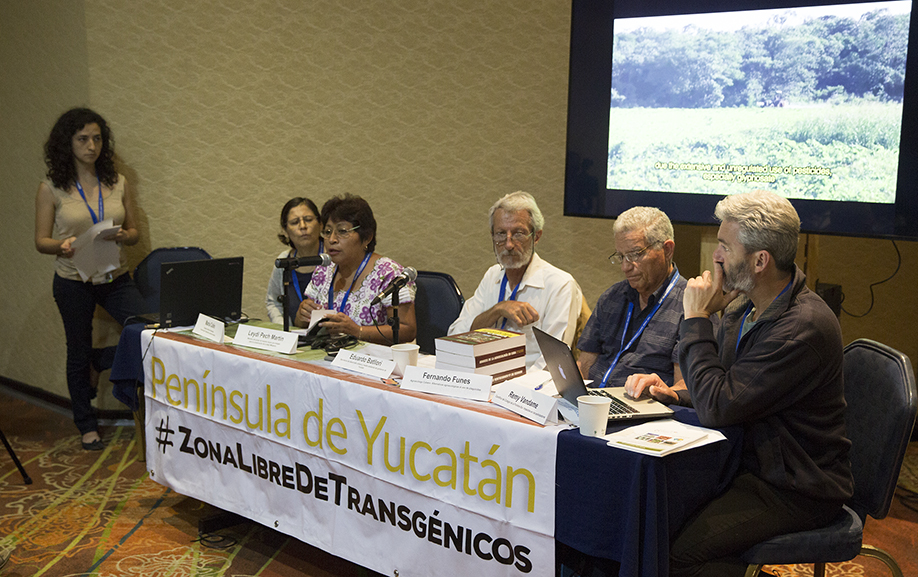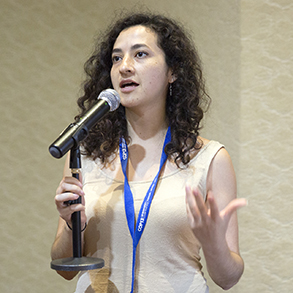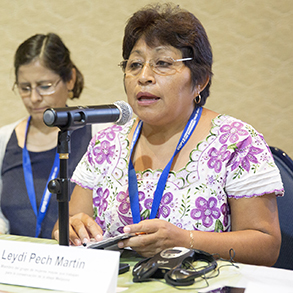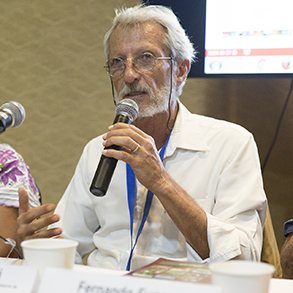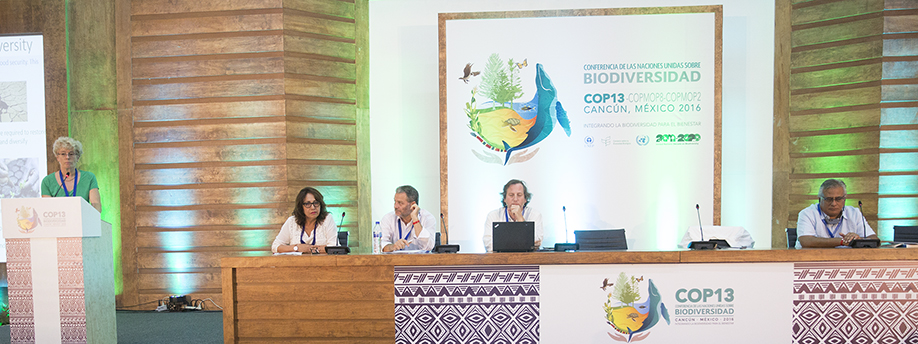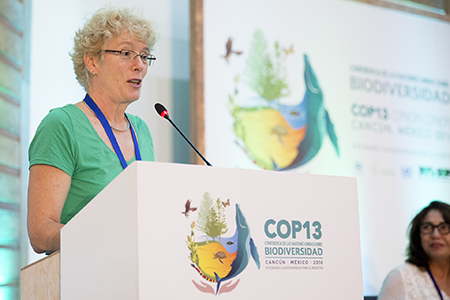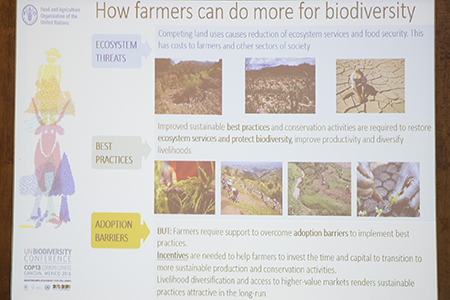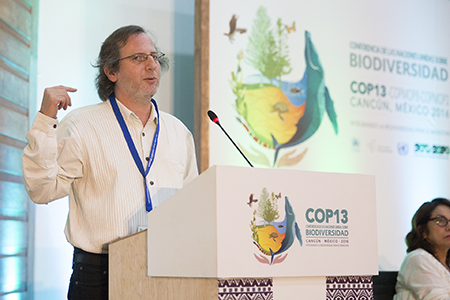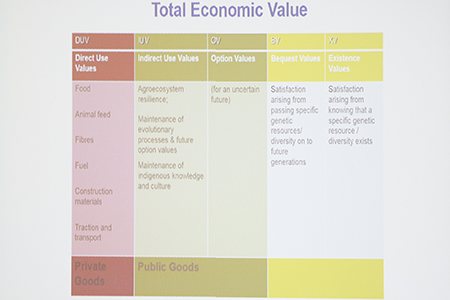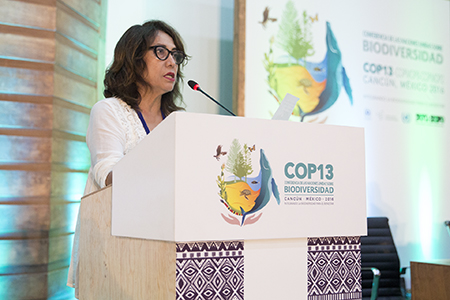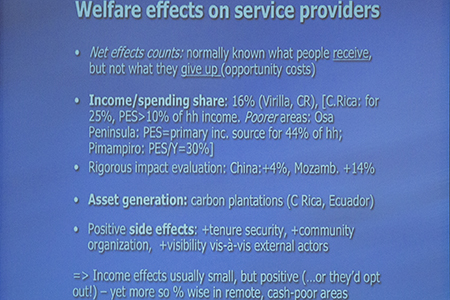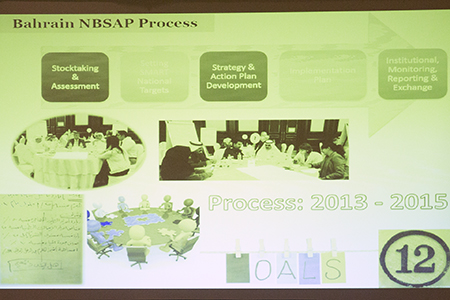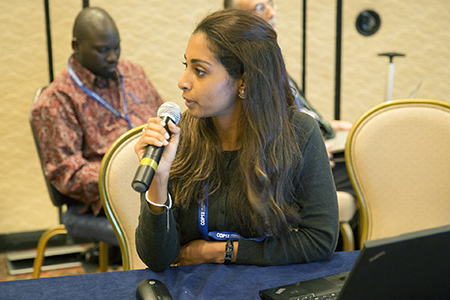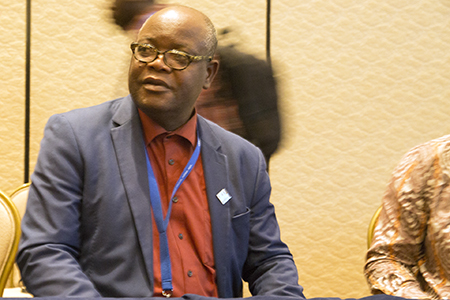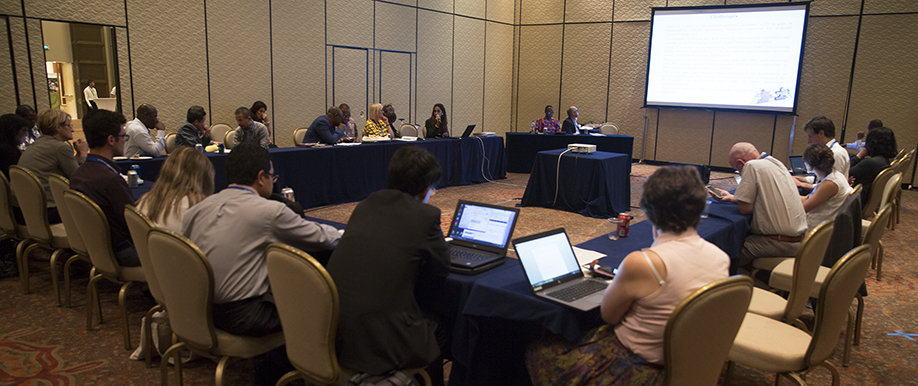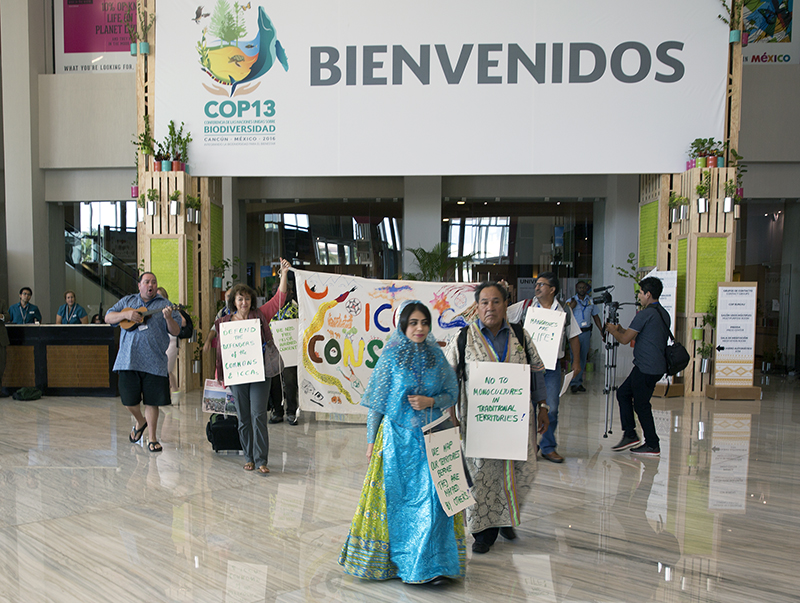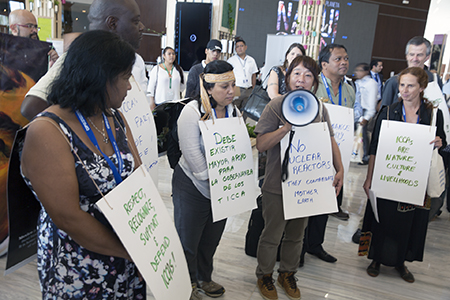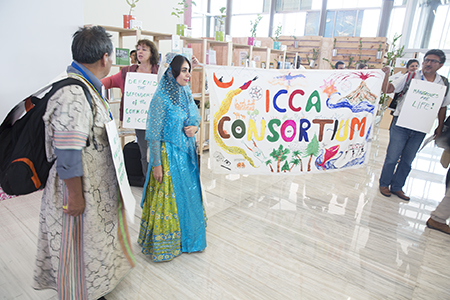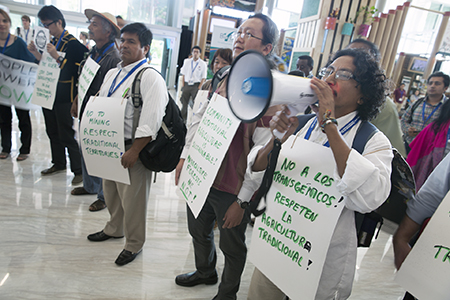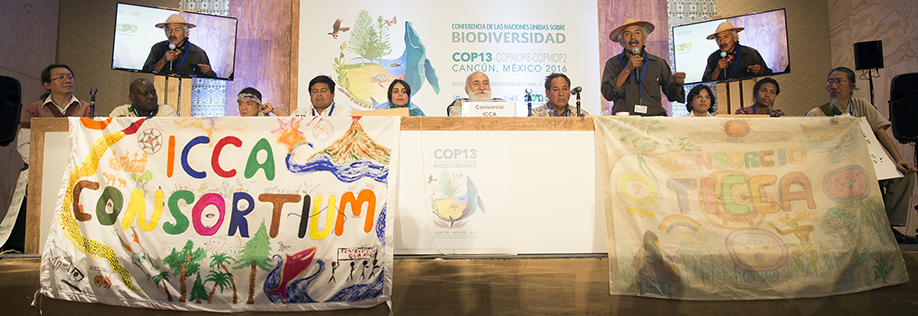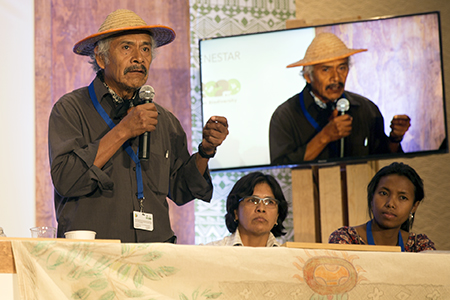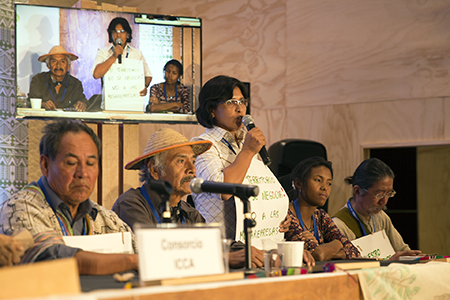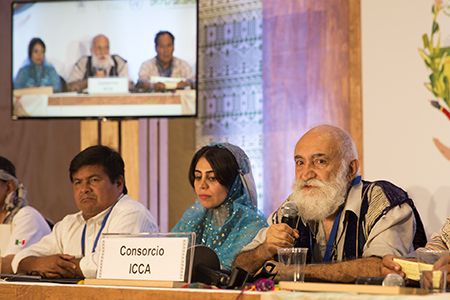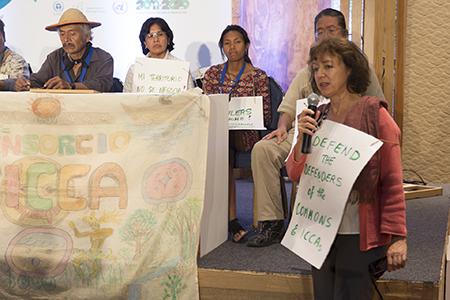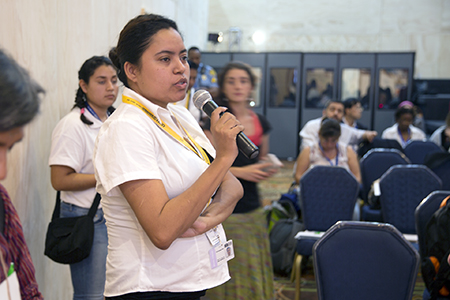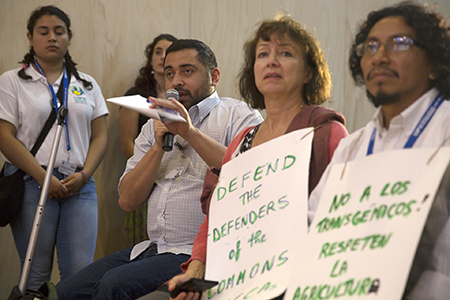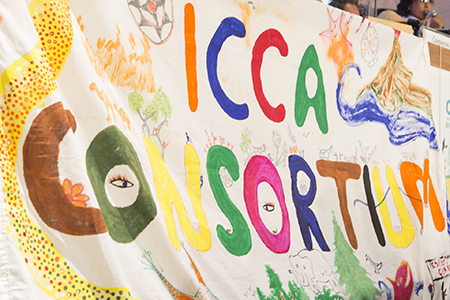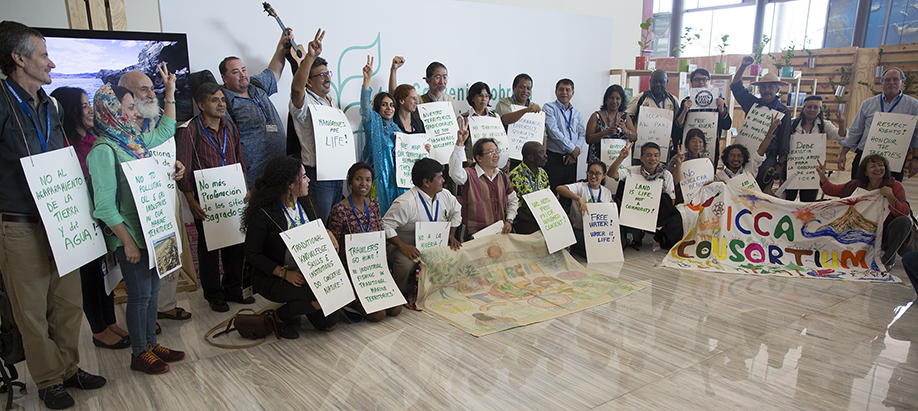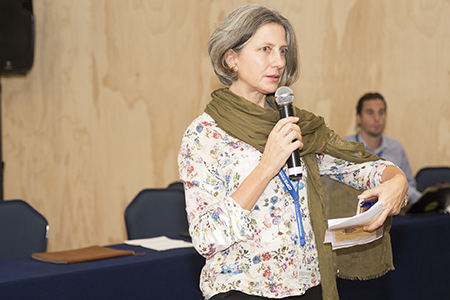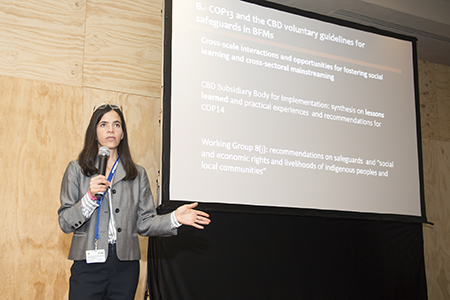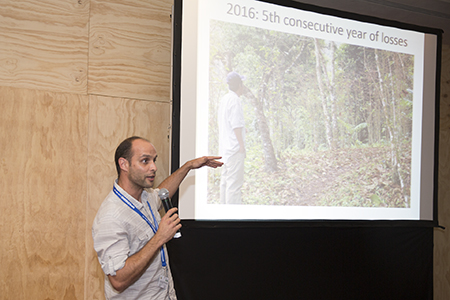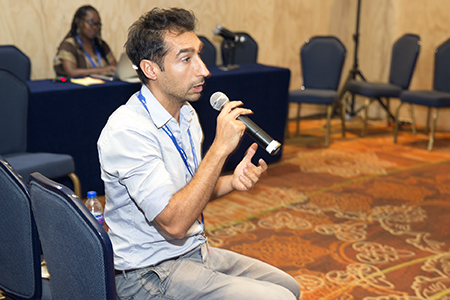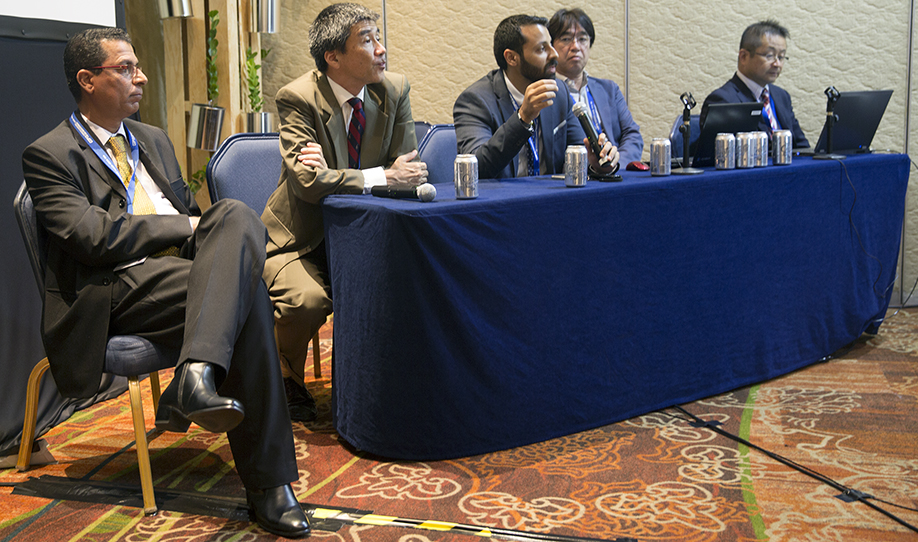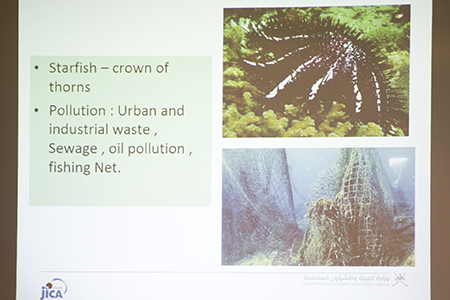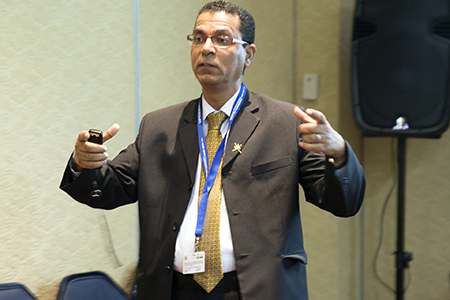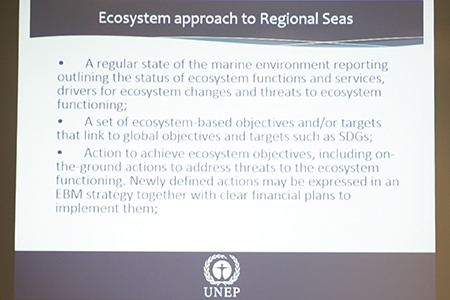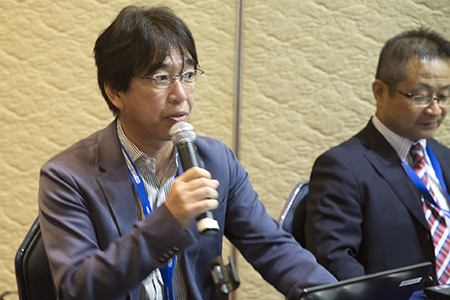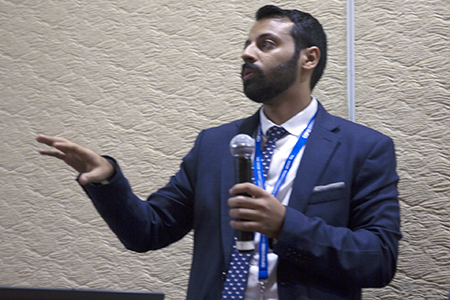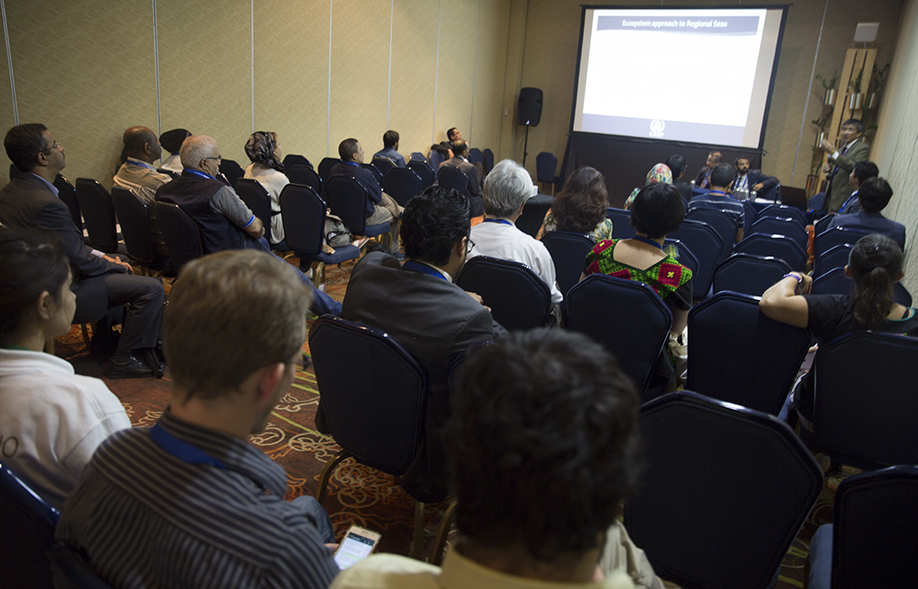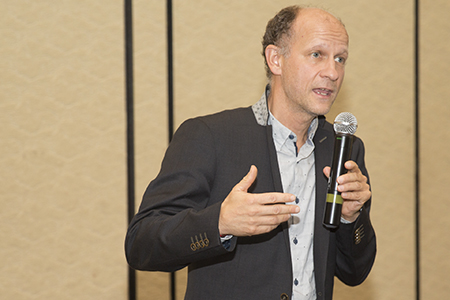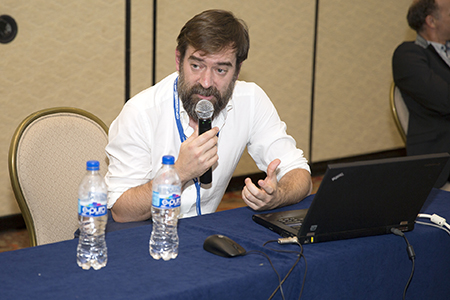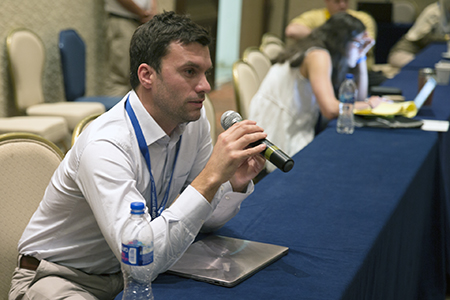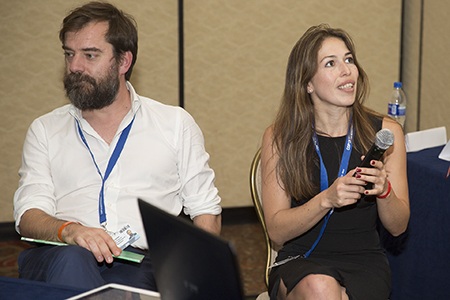Summary
The following events were covered by IISD Reporting Services on Thursday, 15 December 2016:
- Genetically-Engineered (GE) Soy and Pesticides: A Serious Impact to Traditional Maize Crops in its Origin Center
- Assessing the Potential for Multiple Incentive Mechanisms for Ecosystem Services Provision to Support Poor Farmer Livelihoods
- How Effective are National Biodiversity Strategies and Action Plans (NBSAPs) as a Convention on Biological Diversity (CBD) Implementation Tool? An Assessment of Post-2010 NBSAPs
- No to the Plunder of Our Territories! Yes to Indigenous peoples' and community conserved territories and areas (ICCAs) —Territories of Life!
- Convention on Biological Diversity (CBD) Voluntary Guidelines on Safeguards
- Ecosystem Approach in the Regional Organization for the Protection of the Marine Environment (ROPME) Sea Area
- Stocktaking of Global Negotiations and Norms on Access and Benefit Sharing (ABS) and Intellectual Property (IP)
IISD Reporting Services, through its ENBOTS Meeting Coverage, is providing daily web coverage of selected side-events from the UN Biodiversity Conference.
Photos by IISD/ENB | Diego Noguera
For photo reprint permissions, please follow instructions at our Attribution Regulations for Meeting Photo Usage Page.
Genetically-Engineered Soy and Pesticides: A Serious Impact to Traditional Maize Crops in Its Origin Center
Presented by Greenpeace International and Greenpeace Mexico
This side event, moderated by Sandra Laso, Greenpeace Mexico, provided a forum to discuss effects, responses and solutions in regards to transgenic soy plantations in the Yucatán Peninsula. Laso said agricultural landscapes and communities in Mexico are increasingly threatened by changing agricultural practices, particularly due to the use of transgenics.
Leydi Pech Martín, Beekeeper, Campeche State, discussed socio-cultural impacts of transgenic soy in Yucatán Peninsula, reporting that several municipalities have already been negatively affected by contamination of honey by transgenic pollen and toxic pesticides. She noted that soy “was planted before we were consulted and therefore there was no free prior and informed consent (FPIC).”
Rémy Vandame, The College of the Southern Border (ECOSUR), said the debate over transgenic crops is as old as the transgenic era, adding that biotechnology has failed to keep its promises of high yields. He reported evidence of transgenic pollen-contaminated honey in the Yucatán Peninsula, arguing that contrary to promises by promoters of transgenic soy, bees are indeed visiting transgenic plantations.
Eduardo Batllori Sampedro, Minister of Urban Development and Environment, Yucatán Government, said the first evidence of transgene-contaminated honey in the Yucatán appeared in 2009, and pointed to existing evidence of chemical residues in water and the environment. In spite of this, he noted, data deficiency was a constraint to declaring Yucatán a transgene-free zone for soy and corn. He noted that the main justification used for the ban was the breach to the human rights to a healthy environment and culture.
Fernando Funes, Estación Experimental “Indio Hatuey,” Cuba, said reverting to ecoagriculture after periods of industrial agriculture has enabled restoration of crop varieties, indigenous agricultural systems and on-farm biological diversity in Cuba. He said integrated farms are supporting livelihoods and cited benefits, such as sugarcane-based biofuels, farmer-to-farmer fairs and timber wood lots.
María Colín, Greenpeace Mexico, outlined the struggle in Yucatán to have a transgenic-free territory, saying the lack of application of the precautionary approach presents a legal problem. She said the lawsuit, submitted by Yucatán apiculture farmers against transgenetic soy, cited: human and biodiversity health issues including the carcinogenous nature of glyphosate; risk of transgenic seed dispersion by hurricanes; and the lack of FPIC. She reported that even though the ruling was in favor of Yucatán, corruption and impunity have “marred progress.”
(L-R): Sandra Laso, Greenpeace Mexico; María Colín, Greenpeace Mexico; Leydi Pech Martín, Beekeeper, Campeche State; Eduardo Batllori Sampedro, Minister of Urban Development and Environment, Yucatán Government; Fernando Funes, Estación Experimental “Indio Hatuey,” Cuba; and Rémy Vandame, ECOSUR
Sandra Laso, Greenpeace Mexico, moderated the event.
Leydi Pech Martín, Beekeeper, Campeche State, said companies promoting transgenics are breaching the rights of indigenous people.
Eduardo Batllori Sampedro, Minister of Urban Development and Environment, Yucatán Government, said his government is promoting an ecological indigenous agriculture system known as “Milpa.”
Fernando Funes, Estación Experimental “Indio Hatuey,” Cuba said there is no recipe for ecological agriculture and that each region needs to find what works best for them.
Rémy Vandame, ECOSUR, said there is no possible co-existence between apiculture and transgenic soy plantations in Mexico.
Contact:
- Sandra Laso (Moderator)
| slaso@greenpeace.org
More Information:
Assessing the Potential for Multiple Incentive Mechanisms for Ecosystem Services Provision to Support Poor Farmer Livelihoods
Presented by Bioversity International, the Food and Agriculture Organization of the UN (FAO), the National Commission for the Knowledge and Use of Biodiversity (CONABIO) and the Government of Peru
This event, moderated by Marleni Ramírez, Bioversity International, discussed the multiple incentives that can be used to support smallholder farmers for sustainable agricultural production, especially in the conservation of agrobiodiversity and in policy support to improve livelihoods.
Irene Hoffmann, Commission on Genetic Resources for Food and Agriculture (CGRFA), FAO, emphasized that “farmers could do more to conserve agrobiodiversity” and described the ‘Incentives for Ecosystem Services in Agriculture (IES)’ initiative of the FAO in integrating diverse ecosystems and farming practices through different funding and incentive possibilities, ranging from public regulation to voluntary investments.
Ramirez identified the need for an integrated agri-food systems approach that promotes diversity in farming systems by ensuring that farmers have access to diverse and high-quality seeds for low-input and resilient farming landscapes. She also stressed that agrobiodiversity conservation should involve both in situ and ex situ conservation.
Sven Wunder, Center for International Forestry Research (CIFOR), via video, presented on the extent to which it is feasible to “kill two birds with one stone” in addressing environmental sustainability and poverty alleviation through payments for ecosystem services (PES). For pro-poor PES, he noted that the poor occupy environmentally-sensitive lands and have low opportunity costs. On constraints for pro-poor PES, he identified the insecurity of land tenure and high transaction costs of providing payments to smallholders. He also stressed that “asset-generating” projects, such as environmentally-friendly agricultural techniques, would be more synergistic with poverty alleviation in the long-run than “activity restricting” PES.
Adam Drucker, Bioversity International, discussed the ‘Payments/Rewards for Agrobiodiversity Conservation Services (PACS/RACS)’ initiative as a means to explore PES in the context of agrobiodiversity conservation. He described various projects that involve competitive tenders for farmers to reveal the opportunity costs of participation in PES. He said one outcome of the initiative would be to diversify farmer livelihoods from only agricultural production so “they can sell a conservation product for the good of the country and the world.”
José Alvarez Alonso, Ministry of the Environment, Peru, identified opportunities for adding value to Peruvian crop varieties, including: favorable global markets for organic and native products; growing political will in the government; and an increasing valorization of Peruvian cuisine. He stressed that the conservation of agrobiodiversity by local communities must be recognized as an ecosystem service and that “we should issue mechanisms to pay for it,” including through a national legal framework.
Rafael Obregón Viloria, CONABIO, spoke on the importance of establishing local and regional alliances with stakeholders to align public policies to the provision of multiple incentives for biodiversity conservation at the smallholder scale. He stressed that federal incentive programmes, such as PES, will not work if they are “blinded” by local relationships and territorial dynamics.”
(L-R): Irene Hoffmann, FAO; Marleni Ramirez, Bioversity International; José Alvarez Alonso, Ministry of the Environment, Peru; Adam Drucker, Bioversity International; and Rafael Obregón Viloria, CONABIO
Irene Hoffmann, FAO, said sustainable practices for conserving agrobiodiversity must be affordable and financially attractive.
A slide from Irene Hoffmann’s presentation.
Adam Drucker, Bioversity International, said training at the community level was provided on the use of competitive tenders for PES.
A slide from Adam Drucker’s presentation
Marleni Ramirez, Bioversity International, said twelve crops and five animal species provide 75% of the world’s food.
Sven Wunder, CIFOR, presented, via video, on synergies and constraints of PES for poverty alleviation.
Contact:
- Adam Drucker (Coordinator)
| a.drucker@cgiar.org
More Information:
How Effective Are National Biodiversity Strategies and Action Plans (NBSAPs) as a Convention on Biological Diversity (CBD) Implementation Tool? An Assessment of Post-2010 NBSAPs
Presented by Fridtjof Nansen Institute (FNI) and UN Environment
This event, moderated by Elizabeth Maruma Mrema, UN Environment, heard findings of an ongoing FNI assessment on second generation NBSAPs and country experiences of post-2010 NBSAP development.
Christian Prip, FNI, presented on an assessment of second generation NBSAPs that is near completion. Among key conclusions, he noted: that the second generation of NBSAPs are much more targeted; have a stronger focus on mainstreaming; and address the need for legal reform to a larger extent than the first generation of NBSAPs. He noted, however, that the second generation of NBSAPs: have often been prepared in a less participatory way; have targets on mainstreaming that are often worded as broad aspirations with a lack of clarity on how mainstreaming is to be operationalized; and are often not specific about the legal changes needed to achieve them.
Gaston Akouehou, Benin, highlighted the focus of his country’s updated 2011-2020 NBSAP on biodiversity conservation, sustainable use and equitable sharing of benefits. Among various “domains of actions,” he noted: the establishment of a mechanism for planning, management of knowledge and capacity building around biodiversity; and strengthening of the political, institutional, legislative, regulatory and financial frameworks for biodiversity management, climate change, sustainable land management and disaster risk reduction.
Birthe Ivars, Norway, highlighted experiences with developing Norway’s most recent NBSAP, including: the need to ensure ownership and political commitment across ministries; a more ambitious NBSAP as a result of discussions in parliament; and difficulties in obtaining input from the private sector, but interest from the research community.
Reem Al Mealla, Bahrain, highlighted experiences with updating Bahrain’s NBSAP. Among key outcomes, she emphasized: the establishment of the National Environment Trust Fund for the implementation of various NBSAP actions; Bahrain’s first national biodiversity database; and the establishment of the first CBD Clearing-House Mechanism among the countries of the Gulf Cooperation Council.
During discussions, participants raised, inter alia: administrative challenges to national adoption of NBSAPs; whether certain countries are simply continuing to pursue existing policies as opposed to addressing all the Aichi Biodiversity Targets, “similar to what we see with the Sustainable Development Goals (SDGs)”; that NBSAPs are less ambitious than the global biodiversity targets, and that even these NBSAPs will likely lack the means of implementation necessary for implementation; and that the CBD has become “overambitious” by “linking biodiversity to everything,” and may need to shift its focus to low-hanging fruit for a more realistic workload.
Participants also discussed: that many developed countries have a “loose relationship” with the Aichi Biodiversity Targets, but should address them more seriously in their NBSAPs given their international commitments; that many developing country NBSAPs follow the CBD Secretariat’s guidance, but do not seem to have the “political buy-in” to achieve an ambitious agenda; the need to bring about “alternative livelihoods” to delink people’s means of survival from the resources they are trying to protect; benefits of using the NBSAP Forum; and UN Environment’s work on synergies between the SDGs and NBSAPs.
Elizabeth Maruma Mrema, UN Environment, moderated the event.
Christian Prip, FNI, stressed that biodiversity mainstreaming is about “transformative changes in values, decision making and practices,” requiring political buy-in from those involved and legal frameworks to hold them accountable.
A slide from Reem Al Mealla’s presentation.
Reem Al Mealla, Bahrain, highlighted the need: for an updated national database to “fill in the information gaps”; to increase human capital at Bahrain’s Supreme Council for the Environment; for more private-public and private-private partnerships; and to introduce biodiversity conservation in national education curricula.
Birthe Ivars, Norway, highlighted the value of adopting her country’s NBSAP in the form of a white paper, noting it demonstrated increased commitment and makes it more difficult for more “economic” sectors to reopen it.
Gaston Akouehou, Benin, noted that Benin’s 2011-2020 NBSAP focuses on cross-cutting actions to ensure achievement of results.
Participants during the event
Contact:
- Elizabeth Maruma Mrema (Moderator)
| elizabeth.mrema@unep.org
More Information:
No to the Plunder of Our Territories! Yes to Indigenous peoples’ and community conserved territories and areas (ICCAs) —Territories of Life!
This “flash event” was organized by the ICCA Consortium, and was immediately followed by a press conference with ICCA members.
Taghi Farvar, Iran and President of the ICCA Consortium, opened the press conference and said that the flash event was a dramatization of the plunder of indigenous peoples (IPs) lands and territories.
Paul Sein Twa, Myanmar, said that each day, rotational farming is criminalized in his country. He stressed that rotational agriculture is compatible with maintaining forests, and called on governments to promote rotational farming. Vincent Ziba, Zambia, said that ICCAs are part of life and need protection, highlighting the threats posed by mining effluent to IPs and their territories.
Giovanni Reyes, the Philippines, stressed that land is life and not a commodity, saying that there is a correlation between IPs and high biodiversity. He underlined that IPs are striving to access and control resources in their territories, noting the threats posed by large-scale developments and extractive industries. Raúl Petsain, Ecuador, stressed that IPs are the guardians of biodiversity and should be part of decision-making processes related to their lands and territories.
Ghanimat Azhdari, Iran, called for respect for IPs’ lands and territories and stressed that ICCAs need to be mapped by IPs. Saying “no to nationalization,” Farvar stressed that IPs have been working to conserve their lands and resources for centuries, contributing to the conservation of biodiversity.
Juan Chávez, Peru, underscored his support for “no to monocultures in traditional territories,” noting that IPs are opposed to extractive resource practices, and that their fight for the forests is a fight for the life of humankind.
Julián López, Mexico, stressed that IPs must be able to decide how to use their resources in their territories, and should be included in the negotiation processes that will have a direct effect on their livelihoods.
Rosario Banadas, Bolivia, stressed her opposition to destructive, capitalistic development, and underlined the need to protect the rights of IPs who have been guardians of the land for centuries, maintaining clean air, water and healthy lives.
Vatosoa Rakotondrazafy, Madagascar, noted her opposition to industrial fishing in traditional marine territories, and highlighted the need to empower communities to plant and restore mangroves, and put in place customary laws to be respected at the community level.
Sutej Hugu, Taiwan, noted that nuclear waste dumps were relocated to his territory, lamenting that this caused the highest cancer rates in the area. Felipe Gómez, Mexico, stressed that all biodiversity is life, and underscored the need to link between life-giving biodiversity and the promotion of sustainable development. He stressed that it is urgent to include traditional knowledge in science, stressing that IPs do not only fight for themselves, but also for the land itself and the biodiversity it supports.
Panelists then considered questions on, inter alia, the work of the ICCA consortium, how to involve IPs in the management of mangroves, and how to include the IP agenda in the agenda of the Conference of the Parties to the Convention of Biological Diversity.
(L-R): Paul Sein Twa, Myanmar; Vincent Ziba, Zambia; Giovanni Reyes, The Philippines; Raúl Petsain, Ecuador; Ghanimat Azhdari, Iran; Taghi Farvar, Iran and President of the ICCA Consortium; Juan Chávez, Peru; Julián López, Mexico; Rosario Banadas, Bolivia; Vatosoa Rakotondrazafy, Madagascar; and Sutej Hugu, Taiwan
Julian Lopez, Mexico
Rosario Banadas, Bolivia
Felipe Gómez, Mexico
Taghi Farvar, Iran and President of the ICCA Consortium
Juan Chávez, Peru
Giovanni Reyes, the Philippines
Participants ask questions to the panelists.
A group photo at the end of the press conference
Contact:
- Emma Courtine (Coordinator)
| emma@iccaconsortium.org - Albert Chan Dzul (Coordinator)
| albert@iccaconsortium.org
More Information:
Convention on Biological Diversity (CBD) Voluntary Guidelines on Safeguards
Presented by the SwedBio/Stockholm Resilience Centre (SRC)
This side event moderated by Maria Schultz, SwedBio/SRC, discussed the operationalization of the CBD voluntary guidelines on safeguards relevant for biodiversity resource mobilization and for including lessons learned from practice.
Claudia Ituarte-Lima, SwedBio/SRC, reported that the CBD voluntary guidelines for safeguards in biodiversity financing mechanisms (BFMs) were adopted at the twelfth meeting of the Conference of the Parties to the CBD (COP 12). She highlighted elements of the four independent guidelines, including: the role of biodiversity and ecosystem functions for livelihoods and resilience; rights and responsibilities of actors for BFMs; that safeguards for BFMs should be grounded in local circumstances and be country-driven; and that appropriate and effective institutional frameworks are required for transparency and accountability.
Harry Jonas, Natural Justice/IUCN World Commission on Protected Areas (WCPA), said the draft guidelines from the IUCN task force on other effective area-based conservation measures (OEABCMs) will be presented at the twenty-second meeting of the Subsidiary Body on Scientific, Technical and Technological Advice (SBSTTA 22). He provided examples of OEABCMs, including: indigenous conserved areas; natural sacred sites; coastal marine protected areas (MPAs) for reasons other than conservation; and areas in production landscapes that are managed for conservation.
Antoine Libert Amico, Universidad Autónoma Metropolitana (UAM), discussed how coffee leaf rust has, for five consecutive years, led to a loss of shade-dependent Arabica coffee plantations in Mexico. He reported that shifts to more resistant varieties, which require no tree shade, has led to deforestation and forest degradation and presented a BFM project considering, among other things, agricultural insurance of losses, aimed at protecting livelihoods, addressing nutritional deficiency and promoting agroforestry.
Renaud Lapeyre, Institute for Sustainable Development and International Relations (IDDRI), France, discussed practical insights on safeguards from innovative biodiversity conservation projects in Côte d'Ivoire, South Africa and Sierra Leone. He highlighted innovative financial mechanisms with complex contractual arrangements that allow for conditionality, accountability and transparency, and assure result delivery.
Braulio Ferreira de Souza Dias, Executive Secretary, CBD, said with the rise in development funding for infrastructure, there is a need to ensure safeguards to include biodiversity sustainability and the recognition of indigenous peoples’ rights.
Maria Schultz, SwedBio/SRC, moderated the side event.
Claudia Ituarte-Lima, SwedBio/SRC, said safeguards are important tools for mainstreaming biodiversity, protecting people and biodiversity, preventing conflicts and encouraging positive socioecological outcomes.
Harry Jonas, Natural Justice/IUCN WCPA, said the July 2016 IUCN task force meeting on OEABCMs had agreed on a workplan towards the completion of guidance to parties on the meaning of OEABCMs.
Antoine Libert Amico, UAM, outlined safeguards used in a BFM project, which addresses coffee leaf rust elements of rights to access to resource and livelihoods through inter-disciplinary participative research action.
Renaud Lapeyre, IDDRI, said that an innovative governance system in the Gola Forest pilot project in Sierra Leone fostered benefit sharing of carbon credits with communities and respect for traditional rights.
Braulio Ferreira de Souza Dias, Executive Secretary, CBD, said there is little incentive for financial institutions to pay more attention to biodiversity and environmental issues.
Participants during the discussion
Contact:
- Maria Schultz
| maria.schultz@su.se
More Information:
Ecosystem Approach in the Regional Organization for the Protection of the Marine Environment (ROPME) Sea Area
Presented by ROPME, Japan International Cooperation Agency (JICA) and UN Environment
This event, moderated by Takehiro Nakamura, UN Environment, discussed the ROPME Sea Area strategy for ecosystem-based management (EBM).
Kanako Adachi, JICA, identified numerous threats to the marine biodiversity of the ROPME Sea Area and highlighted the 2014 ROPME/JICA Memorandum of Understanding to promote data collection surveys in member states, hold international seminars and regional workshops to promote ecosystem protection, and support bilateral technical cooperation.
Nakamura described EBM as a strategy for integrated management of land, water and living resources to ensure sustainable delivery of ecosystem services in an equitable way, stressing that it involves multiple sectors in relation to the marine and coastal environment. He emphasized that the ROPME/EBM strategy involves: marine ecosystems assessments; the provision of technical advice and guidance on the strategy development process; and alignment with Sustainable Development Goal (SDG) implementation.
Fahad Al-Ajmi, Environment Public Authority (EPA), Kuwait, discussed challenges and practices for coral conservation in Kuwait, including overfishing, recreational diving and coral bleaching caused by climate change. He stressed that the JICA/ROPME partnership will promote the conservation of the marine environment by: designating organizations to manage the marine environment; suggesting amendments to related policies to protect fragile coastal habitats; and linking organizations at the national and regional seas level to implement the EBM strategy.
Badar Al-Bulushi, Ministry of Environment and Climate Affairs, Oman, noted efforts undertaken by his ministry in managing and restoring coral reefs and mangrove areas, including: cleaning campaigns; educating locals; establishing diving rules and regulations; establishing nurseries to rehabilitate mangroves; collaborating with schools; developing monitoring programmes; and building a mangrove information center.
Noriaki Sakaguchi, JICA, highlighted the importance of the JICA collaboration with ROPME in collecting data to support the development of EBM strategies. He also shared experiences of coral restoration projects in Japan with the participation of government agencies, fishermen and farmers.
Yoichi Harada, JICA, identified four common challenges in the ROPME region, which the EBM strategy aims to address: sharing of marine data; environmental awareness raising; development of sustainable aquaculture techniques; and the formation of a uniform environmental monitoring system.
In discussion, participants raised, inter alia, the role of establishing ecologically or biologically significant marine areas for restoring coral reefs and mangroves in the ROPME Sea Area; mangrove restoration technologies; impacts of climate change on the marine environment; and methods to control the crown of thorn starfish.
(L-R): Badar Al-Bulushi, Ministry of Environment and Climate Affairs, Oman; Takehiro Nakamura, UN Environment; Fahad Al-Ajmi, EPA, Kuwait; Noriaki Sakaguchi, JICA; and Yoichi Harada, JICA
A slide from Badar Al-Bulushi’s presentation
Badar Al-Bulushi, Ministry of Environment and Climate Affairs, Oman, noted that coastal development, wastewater discharge and grazing by domestic animals were among the threats to Oman’s mangroves.
Takehiro Nakamura, UN Environment, noted that mainstreaming biodiversity in the management of the ROPME Sea Area requires a set of ecosystem-based targets that link to global objectives and targets such as the SDGs.
A slide from Takehiro Nakamura’s presentation
Noriaki Sakaguchi, JICA, noted that coral reef restoration and management requires the participation of farmers, as sedimentation is a leading threat of reef degradation in Japan.
Fahad Al-Ajmi, EPA, Kuwait, said there is no one solution to coral reef degradation, noting it depends on the key drivers affecting the reef.
Participants during the event
Contact:
- Kanako Adachi (Coordinator)
| Adachi.Kanako@jica.go.jp
More Information:
Stocktaking of Global Negotiations and Norms on Access and Benefit Sharing (ABS) and Intellectual Property (IP)
Presented by the South Centre
This event took stock of various negotiations on genetic resources (GR), traditional knowledge (TK), ABS and IP in a number of international fora and processes.
Viviana Muñoz Tellez, South Centre, noted a proposed amendment from 2011 to the World Trade Organization’s (WTO) Trade-Related Aspects of Intellectual Property Rights (TRIPS) Agreement for any patent application to disclose the country of origin and source of GR and/or associated TK, and evidence of the prior informed consent procedure and mutually agreed terms, on which negotiations are ongoing. She also noted ongoing processes: under the World Intellectual Property Organization (WIPO) on IP and GR, on protection of TK, and on protection of traditional cultural expressions; and in a UN Human Rights Council working group on a declaration on the rights of peasants and other people working in rural areas.
Dan Leskien, Commission on Genetic Resources for Food and Agriculture (CGRFA), noted the Commission’s long history on ABS. He highlighted, inter alia: that the organization is working on a report entitled ‘The State of the World’s Biodiversity for Food and Agriculture’; and the 2016 Elements to Facilitate Domestic Implementation of ABS for Different Subsectors of Genetic Resources for Food and Agriculture (ABS Elements), which aim to assist governments to take into account the importance of GR for food and agriculture.
Álvaro Toledo, International Treaty on Plant Genetic Resources for Food and Agriculture (ITPGRFA), presented ongoing work to enhance the functioning of the ITPGRFA Multilateral System (MLS), including by increasing user-based payments and contributions to the Benefit Sharing Fund in a sustainable, predictable and long-term manner. Among challenges, he noted: whether access mechanisms should be a single access or under subscription mechanism; legal certainty and legal enforcement; and a mechanism for launching the enhanced MLS.
François Meienberg, Public Eye, presented on work that suggests that the instruments and activities of the International Union for the Protection of New Varieties of Plants hinder the application of farmers’ rights as contained in the ITPGRFA. He noted that the new Voluntary Guidance for National Seed Policy Formulation of the Food and Agriculture Organization of the UN could provide a good way forward.
Edward Hammond, Third World Network (TWN), presented on the World Health Organization’s Pandemic Influenza Preparedness Framework, which brings together different stakeholders to take a global approach to pandemic influenza preparedness. He noted ongoing discussions on the topic at the second meeting of the Conference of the Parties serving as the meeting of the Parties (COP-MOP 2) to the Nagoya Protocol on Access to Genetic Resources and the Fair and Equitable Sharing of Benefits Arising from their Utilization.
(L-R): Álvaro Toledo, ITPGRFA; François Meienberg, Public Eye; Dan Leskien, CGRFA;
Edward Hammond, TWN; and Viviana Muñoz Tellez, South Centre
François Meienberg, Public Eye, highlighted his organization’s work opposing patents that are “based on misappropriation.”
A slide from François Meienberg’s presentation
Edward Hammond, TWN, said that despite fears to the contrary, the Nagoya Protocol offers an opportunity to create much legal certainty with regard to work on influenza preparedness and response.
Álvaro Toledo, ITPGRFA, noted that the goal of the MLS is to facilitate access to plant GR for food and agriculture and to share the benefits arising from their use in a fair and equitable way.
A participant asks the panel a question.
Viviana Muñoz Tellez, South Centre, moderated the event.
Contact:
- Viviana Muñoz Tellez (Moderator)
| munoz@southcentre.int

